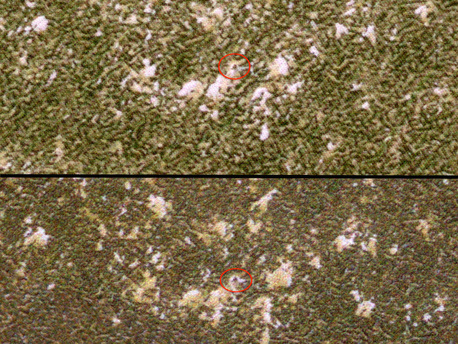Winter on Mars
Frost-Covered Phoenix Lander
 © NASA/JPL-Caltech/University of Arizona |
As the sun began to reappear on the horizon following the deepest, darkest days of north polar winter on Mars, the HiRISE camera imaged the Phoenix landing site on July 30, 2009, (top image) and in Aug. 22, 2009 (bottom).
"We decided to try imaging the site despite the low light levels," said HiRISE team member Ingrid Spitale.
The HiRISE team targeted their camera at the known location of the lander to get the new images and compared them to a HiRISE image of the frost-free lander taken in June 2008. That enabled them to identify the hardware disguised by frost, despite the fact that their views were hindered by poor lighting and by atmospheric haze, which often obscures the surface at this location and season.
Carbon dioxide frost completely blankets the surface in both images. The amount of carbon dioxide frost builds as late winter transitions to early spring, so the layer of frost is thicker in the Aug. 22 image.
HiRISE scientists noted that brightness doesn't necessarily indicate the amount of frost seen in the images because of the way the images are processed to produce optimal contrast. Even the darker areas in the frost-covered images are still brighter than typical soil that surrounds the lander in frost-free images taken during the lander's prime mission in 2008.
Other factors that affect the relative brightness include the size of the individual grains of carbon dioxide ice, the amount of dust mixed with the ice, the amount of sunlight hitting the surface and different lighting angles and slopes, Spitale and Mellon said.
Studying these changes will help us understand the nature of the seasonal frost and winter weather patterns in this area of Mars.
The Phoenix Mars Lander ceased communications last November, after successfully completing its mission and returning unprecedented primary science phase and returning science data to Earth. During the first quarter of 2010, teams at JPL will listen to see if Phoenix is still able to communicate with Earth. Communication is not expected and is considered highly unlikely following the extended period of frost on the lander.
Source: NASA
Winter on Mars
Frost-Covered Phoenix Lander
 © NASA/JPL-Caltech/University of Arizona |
As the sun began to reappear on the horizon following the deepest, darkest days of north polar winter on Mars, the HiRISE camera imaged the Phoenix landing site on July 30, 2009, (top image) and in Aug. 22, 2009 (bottom).
"We decided to try imaging the site despite the low light levels," said HiRISE team member Ingrid Spitale.
The HiRISE team targeted their camera at the known location of the lander to get the new images and compared them to a HiRISE image of the frost-free lander taken in June 2008. That enabled them to identify the hardware disguised by frost, despite the fact that their views were hindered by poor lighting and by atmospheric haze, which often obscures the surface at this location and season.
Carbon dioxide frost completely blankets the surface in both images. The amount of carbon dioxide frost builds as late winter transitions to early spring, so the layer of frost is thicker in the Aug. 22 image.
HiRISE scientists noted that brightness doesn't necessarily indicate the amount of frost seen in the images because of the way the images are processed to produce optimal contrast. Even the darker areas in the frost-covered images are still brighter than typical soil that surrounds the lander in frost-free images taken during the lander's prime mission in 2008.
Other factors that affect the relative brightness include the size of the individual grains of carbon dioxide ice, the amount of dust mixed with the ice, the amount of sunlight hitting the surface and different lighting angles and slopes, Spitale and Mellon said.
Studying these changes will help us understand the nature of the seasonal frost and winter weather patterns in this area of Mars.
The Phoenix Mars Lander ceased communications last November, after successfully completing its mission and returning unprecedented primary science phase and returning science data to Earth. During the first quarter of 2010, teams at JPL will listen to see if Phoenix is still able to communicate with Earth. Communication is not expected and is considered highly unlikely following the extended period of frost on the lander.
Source: NASA





